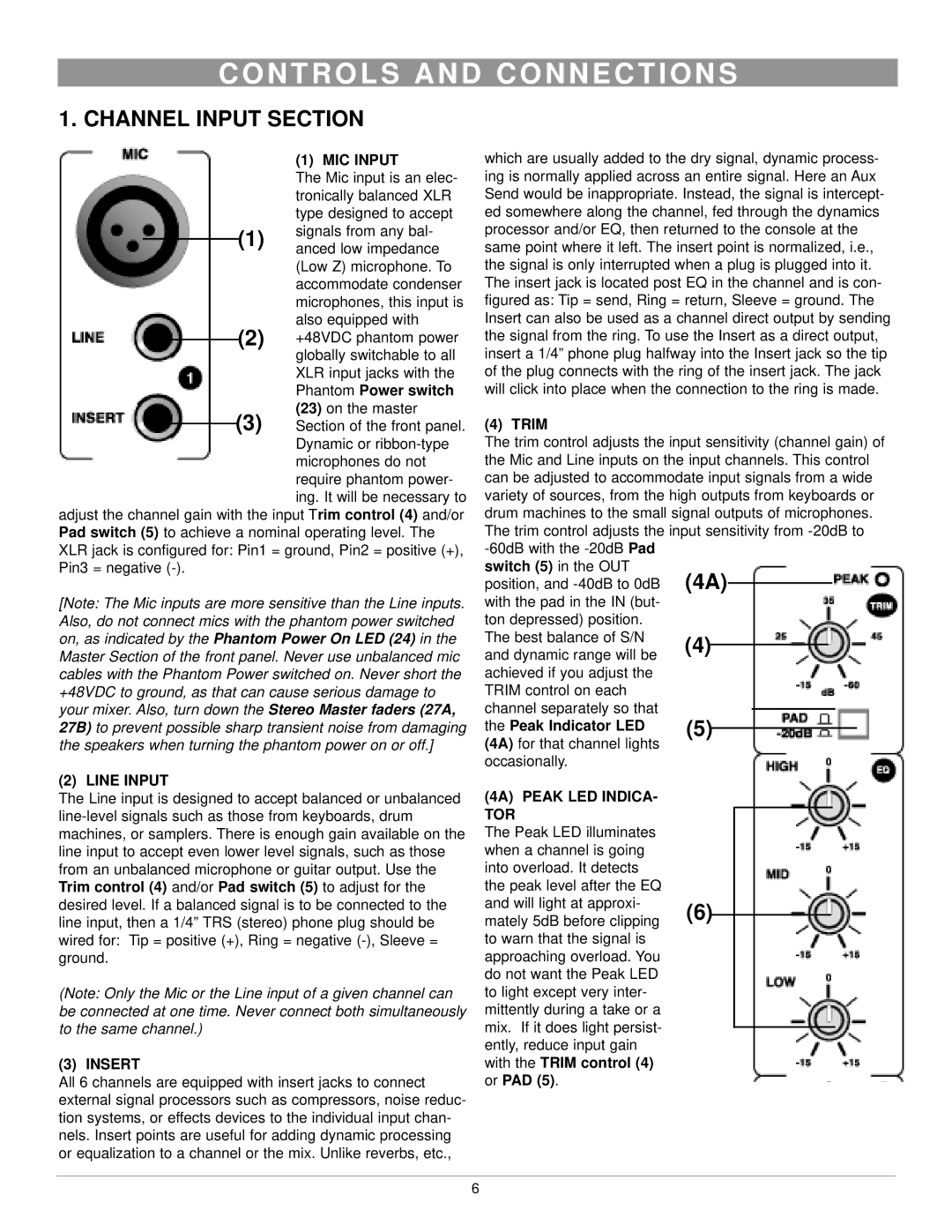
C O N T R O L S A N D C O N N E C T I O N S
1.CHANNEL INPUT SECTION
(1)MIC INPUT
|
|
|
|
|
| The Mic input is an elec- |
|
|
|
|
|
| tronically balanced XLR |
|
|
|
|
|
| type designed to accept |
|
|
|
| (1) | signals from any bal- | |
|
|
|
| anced low impedance | ||
|
|
|
|
|
| |
|
|
|
|
|
| (Low Z) microphone. To |
|
|
|
|
|
| accommodate condenser |
|
|
|
|
|
| microphones, this input is |
|
|
|
|
| (2) | also equipped with |
|
|
|
| +48VDC phantom power | ||
|
|
| ||||
|
|
|
|
|
| globally switchable to all |
|
|
|
|
|
| XLR input jacks with the |
|
|
|
|
|
| Phantom Power switch |
|
|
| (3) | (23) on the master | ||
|
| Section of the front panel. | ||||
| ||||||
Dynamic or
adjust the channel gain with the input Trim control (4) and/or Pad switch (5) to achieve a nominal operating level. The XLR jack is configured for: Pin1 = ground, Pin2 = positive (+), Pin3 = negative
[Note: The Mic inputs are more sensitive than the Line inputs. Also, do not connect mics with the phantom power switched on, as indicated by the Phantom Power On LED (24) in the Master Section of the front panel. Never use unbalanced mic cables with the Phantom Power switched on. Never short the +48VDC to ground, as that can cause serious damage to your mixer. Also, turn down the Stereo Master faders (27A, 27B) to prevent possible sharp transient noise from damaging the speakers when turning the phantom power on or off.]
(2) LINE INPUT
The Line input is designed to accept balanced or unbalanced
(Note: Only the Mic or the Line input of a given channel can be connected at one time. Never connect both simultaneously to the same channel.)
(3) INSERT
All 6 channels are equipped with insert jacks to connect external signal processors such as compressors, noise reduc- tion systems, or effects devices to the individual input chan- nels. Insert points are useful for adding dynamic processing or equalization to a channel or the mix. Unlike reverbs, etc.,
which are usually added to the dry signal, dynamic process- ing is normally applied across an entire signal. Here an Aux Send would be inappropriate. Instead, the signal is intercept- ed somewhere along the channel, fed through the dynamics processor and/or EQ, then returned to the console at the same point where it left. The insert point is normalized, i.e., the signal is only interrupted when a plug is plugged into it. The insert jack is located post EQ in the channel and is con- figured as: Tip = send, Ring = return, Sleeve = ground. The Insert can also be used as a channel direct output by sending the signal from the ring. To use the Insert as a direct output, insert a 1/4” phone plug halfway into the Insert jack so the tip of the plug connects with the ring of the insert jack. The jack will click into place when the connection to the ring is made.
(4) TRIM
The trim control adjusts the input sensitivity (channel gain) of the Mic and Line inputs on the input channels. This control can be adjusted to accommodate input signals from a wide variety of sources, from the high outputs from keyboards or drum machines to the small signal outputs of microphones. The trim control adjusts the input sensitivity from
switch (5) in the OUT | (4A) |
|
|
|
|
| ||
position, and |
|
|
|
| ||||
|
| |||||||
with the pad in the IN (but- |
|
|
|
|
|
|
|
|
ton depressed) position. |
|
|
|
|
|
|
|
|
The best balance of S/N | (4) |
|
|
|
|
|
|
|
and dynamic range will be |
|
|
|
|
|
|
| |
|
|
|
|
|
|
|
| |
achieved if you adjust the |
|
|
|
|
|
|
|
|
TRIM control on each |
|
|
|
|
|
|
|
|
channel separately so that | (5) |
|
|
|
|
|
| |
|
|
|
|
|
| |||
the Peak Indicator LED |
|
|
|
|
|
| ||
|
|
|
|
|
| |||
(4A) for that channel lights |
|
|
|
|
occasionally. |
|
|
|
|
(4A) PEAK LED INDICA- |
|
|
|
|
TOR |
|
|
|
|
The Peak LED illuminates |
|
|
|
|
when a channel is going |
|
|
|
|
into overload. It detects |
|
|
|
|
the peak level after the EQ |
|
|
|
|
and will light at approxi- | (6) |
|
|
|
mately 5dB before clipping |
|
|
| |
|
|
| ||
|
|
|
| |
to warn that the signal is |
|
|
|
|
approaching overload. You |
|
|
|
|
do not want the Peak LED |
|
|
|
|
to light except very inter- |
|
|
|
|
mittently during a take or a |
|
|
|
|
mix. If it does light persist- |
|
|
|
|
|
|
|
| |
ently, reduce input gain |
|
|
|
|
with the TRIM control (4) |
|
|
|
|
or PAD (5). |
|
|
|
|
6
